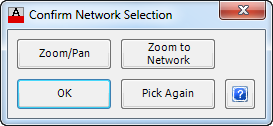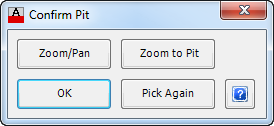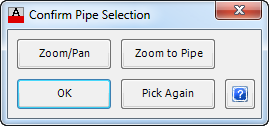Active Network Settings
| Icon: |
|
| Menu: | Pipes > Settings > Active Network Settings |
| Ribbon: | Pipes Tab > Settings Panel > Active Network |
Introduction
----- SPECIAL NOTE TO USA CUSTOMERS: Some of the terminology referred to on this page may differ from this help. Sections referring to hydrology settings, such as IFD tables, under the Drainage tab will not be displayed -----
The CSD Pipes module of Civil Site Design software requires the Designer to setup what pipes & structures are available, how they want the software to perform and how objects are displayed for a specific drawing (or project).
The Active Network Settings form includes multiple tabs for control over the following functionality and object display:
- Pipe, Box Section, Utility Obstruction and Structure tables including geometric and hydraulic properties;
- Object layer & labelling display controls;
- Object snapping tolerances settings;
- Drainage rainfall table definition (IDF & Log co-efficient);
- Sewer design tables and House Connection definition;
The Active Network Settings is used to control the settings for the current drawing only, also referred to as Local Settings.
The initial settings for this form are populated from the selected Global Network Settings when a project is first started. The Global Network Settings command is used to edit a Global Network Settings file.
Details
Upon selecting the command, the following form is displayed:
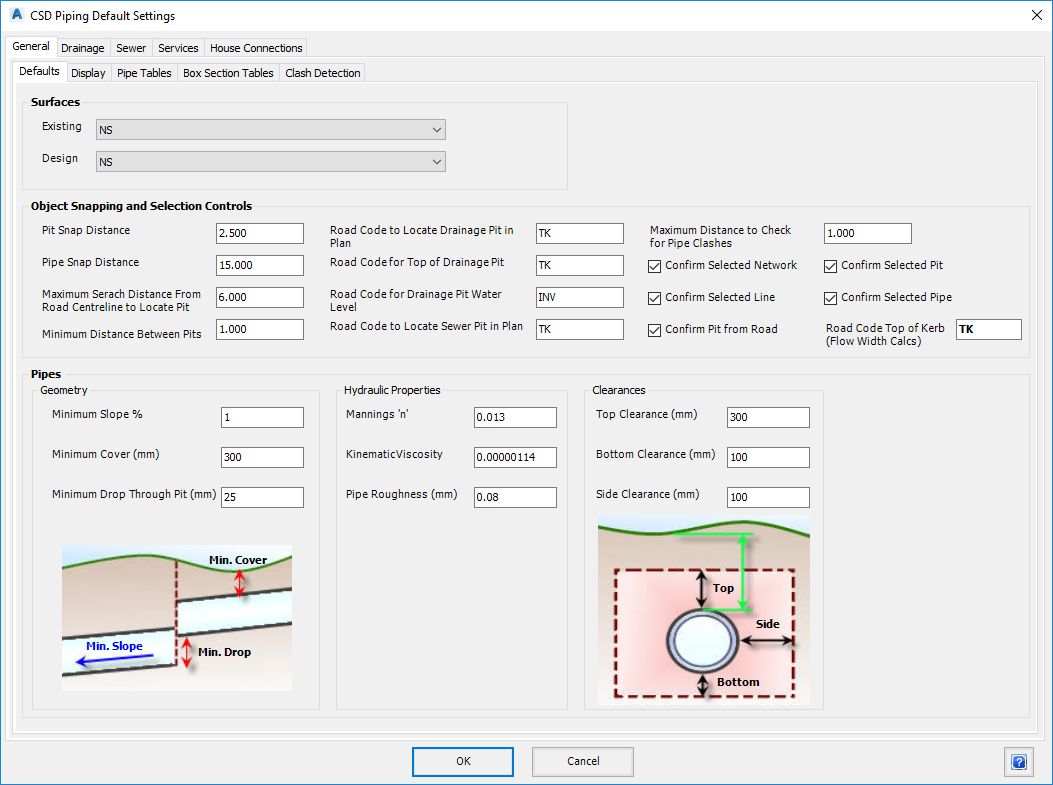 The Active Network Settings is broken up into several main tabs: (Click on a tab for more information about that tab):
|
|
| OK | Apply and exit. |
| Cancel | Exit the form without deleting any data. |
General Tab
The General tab is used to configure project settings common to all network types (Drainage, Sewer and Utilities Obstructions). It is divided up into the following tabs (Click on a tab for more information about that tab):

Defaults Tab
The General - Defaults tab is used to configure the surfaces, object snapping and pipe default geometric, hydraulic and clearance properties.
Note: To adjust the focus to show information about a different tab, just click on the tab of interest.
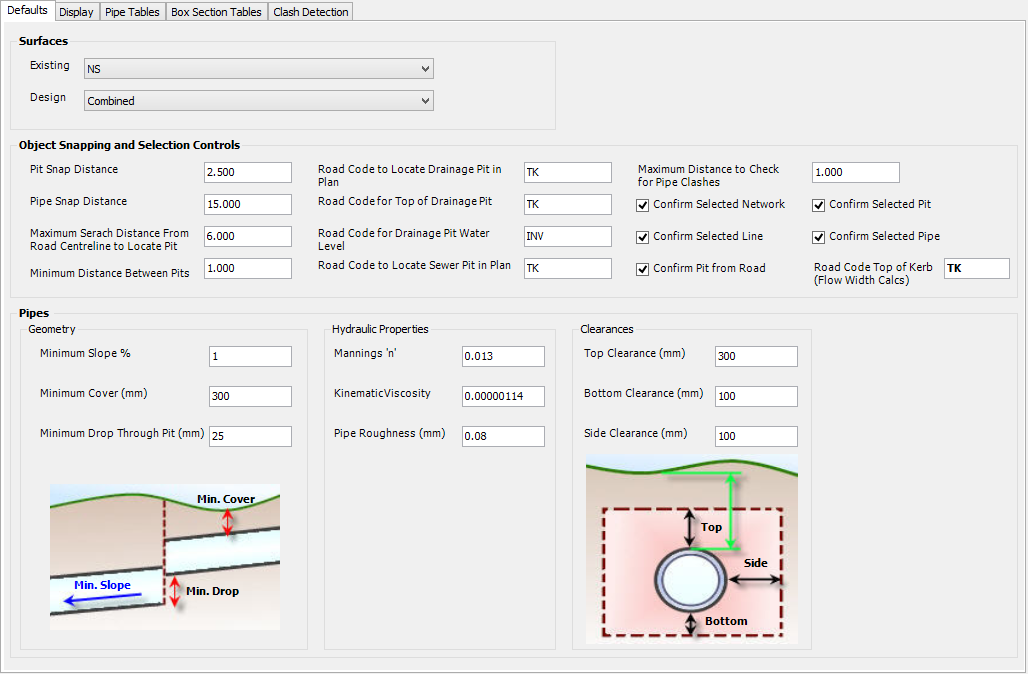
|
|
| Surfaces | Select the surface (terrain) models that are used as the Existing and Design surfaces for the project. |
| Existing | Select the surface to be used as the Existing surface. |
| Design | Select the surface to be used as the Design surface. The surface must exist for all structure and pipe locations. The Design Surface is used for calculating pipe cover and is the default surface used for locating the top of structures. |
| Object Snapping and Selection Controls | Set the object snapping options for Structure & Pipe creation and editing. |
| Structure Snap Distance | Set the distance (in drawing units) to snap when selecting a structure. |
| Pipe Snap Distance | Set the distance (in drawing units) to snap when selecting a pipe. |
| Maximum Search Distance From Road Centreline to Locate Structure | Set the maximum distance (in drawing units) from any Road centreline the software will search for when locating a structure. When a structure is being created and a location is specified within the search distance to a road, the user will be given the option to associate it to the Road. |
| Minimum Distance Between Structures | Set the minimum distance (in drawing units) between structures. If the minimum distance is violated when locating a structure, the user will be prompted with a warning message. |
| Road Code to Locate Drainage Structure in Plan | Specify the default Road Code to locate a drainage structure. The code must be entered without the L or R prefix. |
| Road Code for Top of Drainage Structure | Specify the default Road Code the top of a drainage structure is associated with. The code must be entered without the L or R prefix. |
| Road Code for Drainage Structure Water Level | Specify the default Road Code the hydraulic design level of a drainage structure is associated with. The code must be entered without the L or R prefix. |
| Road Code to Locate Sewer Structure in Plan | Specify the default Road Code to locate a sewer structure. The code must be entered without the L or R prefix. |
| Maximum Distance to Check for Pipe Clashes | Specify the maximum distance (in drawing units) to check for pipe clashes. The network type to be included in clash detection are set on the Clash Detection tab. |
| Confirm Selected Network | Enables or disables the Confirm Network
when selecting a network.
|
| Confirm Selected Line | Enables or disables the Confirm Line
(or Branch) when selecting a line/branch of a network.
|
| Confirm Structure from Road | Enables or disables the Confirm
Structure
from Road when creating structure associated with a road.
Note: In the Road List, offset is distance first, followed by the Chainage, then the Alignment Name. |
| Confirm Selected Structure | Enables or disables the Confirm
Structure
form when selecting a structure.
|
| Confirm Selected Pipe | Enables or disables the Confirm Pipe
form when selecting a pipe.
|
| Road Code Top of Kerb (Flow Width Calcs) | In order to determine the road extents within which to calculate the water depths at structures, users need to specify a Code from the Road cross sections that represents the outside edge for depth calculations. Normally this would be the top of kerb (TK) or back of kerb. Users can set this code themselves here. |
| Pipes | Define the overall properties for the all the Pipes (including Box Sections) if no other values are defined for the class default or object itself. |
| Geometry | Define the overall geometry properties. |
| Minimum Slope % | Set the minimum slope as a percentage. |
| Minimum Cover (mm) | Set the minimum cover in millimetres. |
| Minimum Drop Through Structure (mm) | Set the minimum drop through the structure in millimetres. |
| Hydraulic Properties | Define the overall hydraulic properties. |
| Mannings 'n' | Set the Mannings 'n' number. |
| Kinematic Viscosity | Set the Kinematic Viscosity value. |
| Pipe Roughness (mm) | Set the Pipe Roughness value in millimetres. |
| Clearances | Define the overall clearances. |
| Top Clearance (mm) | Set the top clearance from the outside of the pipe in millimetres. |
| Bottom Clearance (mm) | Set the bottom clearance from the outside of the pipe in millimetres. |
| Side Clearance (mm) | Set the side clearance from the outside of the pipe in millimetres. |
Display Tab
The General - Display tab is used to configure the display of the various pipe networks & labelling and also the object highlight settings.
Note: To adjust the focus to show information about a different tab, just click on the tab of interest.

|
|
| Drainage Networks | Configure the display controls for Drainage Networks. |
| Layer | Select the layer used to display drainage
networks (structures, pipes, direction arrows and pipe labels). The
structure labels are displayed on a layer the same as selected with
the same name plus the suffix -Text. Use the
Edit Layer
Settings command to edit the layers available. The Ignore Legacy Label Plotting toggle will stop these labels from being drawn. |
| Utilities | Configure the display controls for Utility Obstruction Networks. |
| Layer | Select the layer used to display utility obstruction networks (structures, pipes, direction arrows and pipe labels). Use the Edit Layer Settings command to edit the layers available. |
| Structure Block | Select the block used to represent the utility obstruction structures in the drawing. The block is aligned to the downstream pipe when the utility obstruction is created. The blocks are initially loaded from the CSD common folder and then from the drawing. |
| Downstream Structure Symbol | Select the block used to represent the downstream utility obstruction structure for each network. The block is aligned to the downstream pipe when the utility obstruction is created. The blocks are initially loaded from the CSD common folder and then from the drawing. |
| Show Structure ID's | Tick box to enable or disable the display of the structure labels for utility obstruction structures. |
| Show Pipe ID's | Tick box to enable or disable the display of the pipe labels for utility obstruction structures. |
| Sewer Networks | Configure the display controls for Sewer Networks. |
| Layer | Select the layer used to display sewer
networks (structures, pipes, direction arrows and pipe labels). The
structure labels are displayed on a layer the same as selected with
the same name plus the suffix -Text. Use the
Edit Layer Settings
command to edit the layers available. The Ignore Legacy Label Plotting toggle will stop these labels from being drawn. |
| Structure Block | Select the block used to represent the sewer structures in the drawing. The block is aligned to the downstream pipe when the sewer network is defined. The blocks are initially loaded from the CSD common folder and then from the drawing. |
| Downstream Structure Symbol | Select the block used to represent the downstream sewer structure for each network. The block is aligned to the downstream pipe when the sewer network is defined. The blocks are initially loaded from the CSD common folder and then from the drawing. |
| Sewer House Connections | Configure the display controls for Sewer House Connection Networks. |
| Layer | Select the layer used to display sewer house connection networks (structures, pipes, direction arrows and pipe labels). Use the Edit Layer Settings command to edit the layers available. |
| Structure Block | Select the block used to represent the sewer house connection structures in the drawing. The block is aligned to the downstream pipe when the sewer house connection is created. The blocks are initially loaded from the CSD common folder and then from the drawing. |
| Downstream Structure Symbol | Select the block used to represent the downstream sewer house connection structure for each network. The block is aligned to the downstream pipe when the sewer house connection is created. The blocks are initially loaded from the CSD common folder and then from the drawing. |
| Show Structure ID's | Tick box to enable or disable the display of the structure labels for sewer house connection structures. |
| Show Pipe ID's | Tick box to enable or disable the display of the pipe labels for sewer house connection structures. |
| Drainage House Connections | Configure the display controls for Drainage House Connection Networks. |
| Layer | Select the layer used to display drainage house connection networks (structures, pipes, direction arrows and pipe labels). Use the Edit Layer Settings command to edit the layers available. |
| Structure Block | Select the block used to represent the drainage house connection structures in the drawing. The block is aligned to the downstream pipe when the drainage house connection is created. The blocks are initially loaded from the CSD common folder and then from the drawing. |
| Downstream Structure Symbol | Select the block used to represent the downstream drainage house connection structure for each network. The block is aligned to the downstream pipe when the drainage house connection is created. The blocks are initially loaded from the CSD common folder and then from the drawing. |
| Legacy labels | Legacy labels are the automatic structure and pipe labels that are displayed when pipes and structures are created. Initially, structure labels display automated numbers, replaced by Structure ID's or following branch sequencing and assignment of a structure naming convention. |
| Ignore Legacy label plotting | Traditionally, structure and pipe labels were automatically drawn as pipes and structures were created, for drainage and sewer networks. Since Civil Site Design V16 new labelling tools are available, enhancing the drafting control of text, symbols and linework associated with the labels. The Network Labels command can be used for this newer labelling - if this is planned, then the older (duplicate) labelling is probably not required. |
| Use polyline specifications on a class basis | By default, pipes are represented by a single line. Users can however use the command Pipe Draw Settings to set up pipe display using multiple polylines (centreline, inside diameter and outside diameter). Toggle this on to apply multiple polylines to represent the pipe. |
| Plot simple line for pipe with Class plot | As well as applying pipe drafting as per the above toggle and the Pipe Draw Settings command, this toggle will also draw a single centreline line between the structures. |
| Slope Input in Vertical Grading | Users are able to set, on a network-by-network basis, whether to use percentage grades (%) or slopes (rise:run) to design the pipes in the Vertical Grading Editor. Inputs inside the Vertical Grading Editor will be adjusted to match this selection. |
| Drainage | Select to design using slopes (%) or grades (1 in) when editing a Drainage network using the Vertical Grading Editor. |
| Sewer | Select to design using slopes (%) or grades (1 in) when editing a Sewer network using the Vertical Grading Editor. |
| House Connections | Select to design using slopes (%) or grades (1 in) when editing a House Connection using the Vertical Grading Editor |
| Utilities | Select to design using slopes (%) or grades (1 in) when editing a Utility Obstruction using the Vertical Grading Editor. |
| Object Highlight | Configure the Object Highlight controls for all pipes and structures. Selected objects are highlighted by the software to clearly identify a user selection. The current layer is used for the highlight object. |
| Structure Highlight Width | Enter the width of the outer circle of the structure crosshair highlight in millimetres x 100. A crosshair is drawn to indicate the structure selected when the Structure Confirmations are turned on. The structure highlight width is only shown when the Lineweight is enabled in the drawing. |
| Structure Highlight Radius | Enter the radius of the structure highlight in drawing units. |
| Pipe Highlight Width | Enter the width of the line used to highlight a pipe in drawing units. The pipe is highlighted only when the Pipe Confirmations are turned on. |
| Structure ID | Configure the display of Structure labels. The Structure labels can be moved in the drawing and the offsets to the Structure location is maintained by the software. The label can be reset be simply deleting it and refreshing the network display using the Redraw Networks command. A default circle will be displayed around the Structure label. |
| Text Style | Select the text style to be used. |
| Text Height | Enter the text height in drawing units. |
| X offset | Enter the default X offset from the structure insertion point to draw the structure label. |
| Y offset | Enter the default Y offset from the structure insertion point to draw the structure label. |
| Pipe ID | Configure the display of the Pipe labels. Pipe labels are oriented parallel to the pipe. |
| Style for Pipes | Select the text style to be used. |
| Height for Pipes | Enter the text height in drawing units. |
| Offset | Enter the offset from the Pipe centreline for the Pipe label location. |
| Pipe Direction Arrows | Configure the display of the Pipe Direction Arrows. The arrows are only drawn when the pipe and structures are defined as a network. |
| Length | Enter the length in drawing units. |
| Width | Enter the width in drawings units. |
Pipe Tables Tab
The General - Pipe Tables tab is used to configure the various pipe classes and types available in the project.
Note: To adjust the focus to show information about a different tab, just click on the tab of interest.
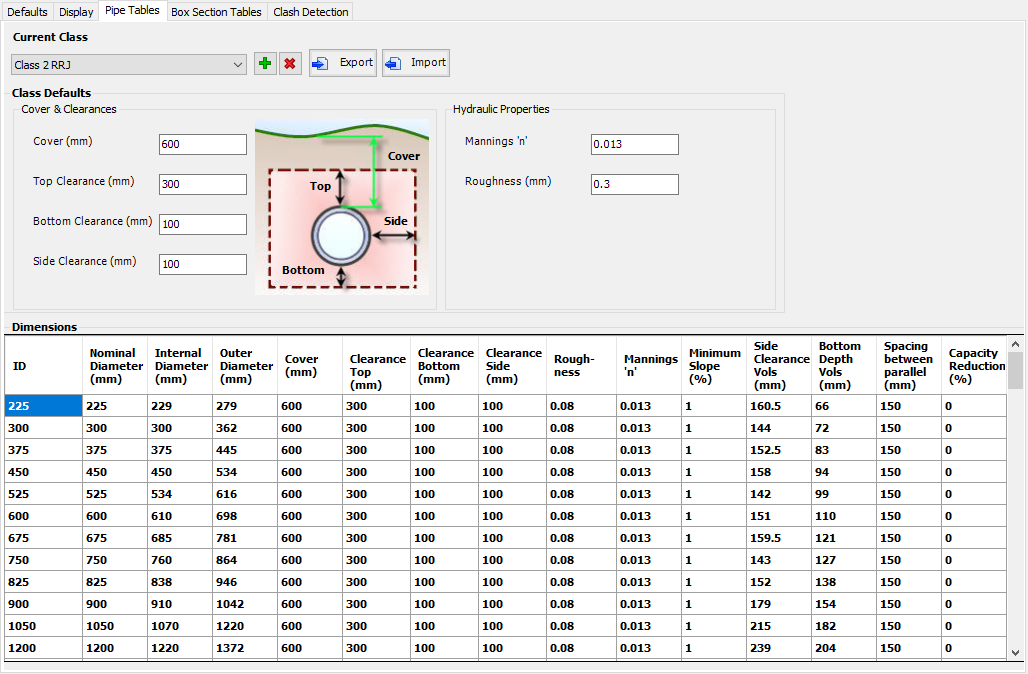
|
|
| Current Class | Select the pipe class to be viewed/edited. |
 New
Class New
Class |
Create a new pipe class. |
 Delete
Current Class Delete
Current Class |
Delete the current pipe class. Note: The 'Default' pipe class cannot be deleted. |
 |
Export the current pipe class to file. See Importing & Exporting Tables below. |
 |
Import a pipe class from file. See Importing & Exporting Tables below. |
| Class Defaults | Set the class defaults. |
| Cover & Clearances | Set the cover and clearances. |
| Cover (mm) | Set the minimum cover in millimetres. |
| Top Clearance (mm) | Set the top clearance from the outside of the pipe in millimetres. |
| Bottom Clearance (mm) | Set the bottom clearance from the outside of the pipe in millimetres. |
| Side Clearance (mm) | Set the side clearance from the outside of the pipe in millimetres. |
| Hydraulic Properties | Set the hydraulic properties. |
| Mannings 'n' | Set the Mannings 'n' number. |
| Roughness (mm) | Set the pipe Roughness value in millimetres. |
| Dimensions | Set the pipe properties for each pipe type in the class. It is recommended that all values are set for each pipe type. |
| ID | Enter the ID (identifier) for the pipe. |
| Nominal Diameter (mm) | Enter the nominal diameter for the pipe in millimetres. |
| Internal Diameter (mm) | Enter the internal diameter for the pipe in millimetres. |
| Outer Diameter (mm) | Enter the outer diameter for the pipe in millimetres. |
| Cover (mm) | Enter the cover for the pipe in millimetres. |
| Clearance Top (mm) | Enter the top clearance from the outside of the pipe in millimetres. |
| Clearance Bottom (mm) | Enter the bottom clearance from the outside of the pipe in millimetres. |
| Clearance Side (mm) | Enter the side clearance from the outside of the pipe in millimetres. |
| Roughness | Enter the pipe roughness value in millimetres. |
| Mannings 'n' | Enter the pipe Mannings 'n' number. |
| Minimum Slope (%) | Enter the minimum pipe slope as a percentage. |
| Side Clearance Vols (mm) | Enter the side clearance from the outside of the pipe in millimetres to be used for a Trench Volume Report. |
| Bottom Depth Vols (mm) | Enter the bottom clearance from the outside of the pipe in millimetres to be used for a Trench Volume Report. |
| Spacing between parallel (mm) | Enter the spacing between pipes (measured from the outside edges of the pipes) when multiple parallel pipes are specified to be used for a Trench Volume Report. |
| Capacity Reduction (%) | Users are able to set a percentage blockage
factor (capacity reduction) per pipe. This value can be applied to the pipes in a Drainage network to show the reduction in Mannings and HGL flow capacity (litres/second) if the capacity reduction factor is applied. Zero implies no reduction. 100 implies total blockage. Note: Users must turn on the option to apply the capacity reduction factors from the Drainage - Design Settings tab. The display of the Hydraulic Grade Line (HGL) in the Vertical Grading Editor will not be affected by the reduction factors applied - designers need to review the reduced flow capacities and surcharges reported by the software. |
Box Section Tables Tab
The General - Box Section Tables tab is used to configure the various box sections classes and types available in the project.
Note: To adjust the focus to show information about a different tab, just click on the tab of interest.
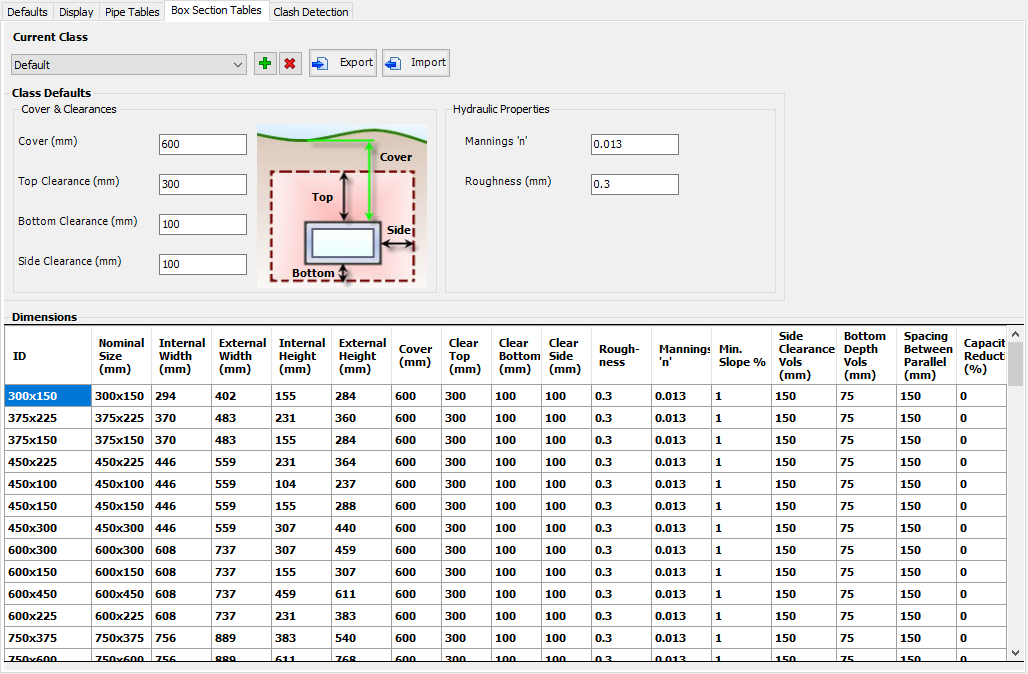
|
|
| Current Class | Select the box section class to be viewed/edited. |
 New
Class New
Class |
Create a new box section class. |
|
|
Delete the current box section class. Note: The 'Default' box section class cannot be deleted. |
|
|
Export the current box section class to file. See Importing & Exporting Tables below. |
|
|
Import a box section class from file. See Importing & Exporting Tables below. |
| Class Defaults | Set the class defaults. |
| Cover & Clearances | Set the cover and clearances. |
| Cover (mm) | Set the minimum cover in millimetres. |
| Top Clearance (mm) | Set the top clearance from the outside of the box section in millimetres. |
| Bottom Clearance (mm) | Set the bottom clearance from the outside of the box section in millimetres. |
| Side Clearance (mm) | Set the side clearance from the outside of the box section in millimetres. |
| Hydraulic Properties | Set the hydraulic properties. |
| Mannings 'n' | Set the Mannings 'n' number. |
| Roughness (mm) | Set the box section Roughness value in millimetres. |
| Dimensions | Set the box section properties for each box section type in the class. It is recommended that all values are set for each box section type. |
| ID | Enter the ID (identifier) for the box section. |
| Nominal Size (mm) | Enter the nominal size for the box section in millimetres. |
| Internal Width (mm) | Enter the internal width for the box section in millimetres. |
| External Width (mm) | Enter the external width for the box section in millimetres. |
| Internal Height (mm) | Enter the internal height for the box section in millimetres. |
| External Height (mm) | Enter the external height for the box section in millimetres. |
| Cover (mm) | Enter the cover for the box section in millimetres. |
| Clear Top (mm) | Enter the top clearance from the outside of the box section in millimetres. |
| Clear Bottom (mm) | Enter the bottom clearance from the outside of the box section in millimetres. |
| Clear Side (mm) | Enter the side clearance from the outside of the box section in millimetres. |
| Roughness | Enter the box section roughness value in millimetres. |
| Mannings 'n' | Enter the box section Mannings 'n' number. |
| Min Slope % | Enter the minimum box section slope as a percentage. |
| Side Clearance Vols (mm) | Enter the side clearance from the outside of the box section in millimetres to be used for a Trench Volume Report. |
| Bottom Depth Vols (mm) | Enter the bottom clearance from the outside of the box section in millimetres to be used for a Trench Volume Report. |
| Spacing Between Parallel (mm) | Enter the spacing between box sections (measured from the outside edges of the box sections) when multiple parallel box sections are specified to be used for a Trench Volume Report. |
| Capacity Reduction (%) | Users are able to set a percentage blockage
factor (capacity reduction) per box section. This value can be applied to the box sections in a Drainage network to show the reduction in Mannings and HGL flow capacity (litres/second) if the capacity reduction factor is applied. Zero implies no reduction. 100 implies total blockage. Note: Users must turn on the option to apply the capacity reduction factors from the Drainage - Design Settings tab. The display of the Hydraulic Grade Line (HGL) in the Vertical Grading Editor will not be affected by the reduction factors applied - designers need to review the reduced flow capacities and surcharges reported by the software. |
Clash Detection Tab
The General - Clash Detection tab is used to configure what type of networks are shown in the Vertical Grading Editor and the Clash Detection Report as crossing objects.
Note: To adjust the focus to show information about a different tab, just click on the tab of interest.

|
|
| Include in Clash Detection | Select the items to be shown in the VGE as crossing pipes and Clash Detection Report as crossing objects. |
| Drainage Pipes | Enable/disable drainage pipes. |
| Sewer Pipes | Enable/disable sewer pipes. |
| Sewer House Connection Pipes | Enable/disable sewer house connection pipes. |
| Utility Pipes | Enable/disable utility obstruction pipes. |
Drainage Tab
The Drainage tab is used to configure project settings specific to Drainage networks. It is divided up into the following tabs (Click on a tab for more information about that tab):

Design Settings Tab
The Drainage - Design Settings tab is used to configure the various design settings used for the analysis of drainage networks.
Note: To adjust the focus to show information about a different tab, just click on the tab of interest.
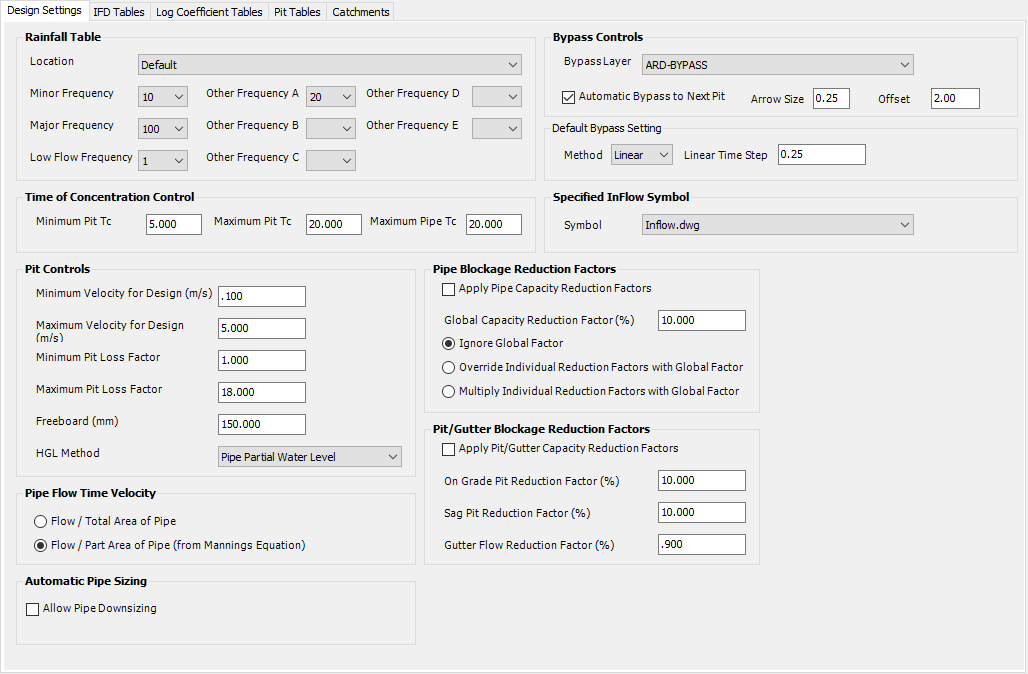
|
|
| Rainfall Table (Metric Versions ONLY) | Define the rainfall location and frequencies to be used for the drainage analysis. |
| Location | Select the location to be used. Either an IFD or a Log Coefficient table can be selected. |
| Minor Frequency | Select the frequency to be used as the minor storm event. The pipes are sized and their invert levels established based on this setting. A value MUST be selected for the Minor Frequency. |
| Major Frequency | Select the frequency to be used as the major storm event. Leave blank if not required. |
| Low Flow Frequency | Select the frequency to be used as the low flow (GPT Design) event. Leave blank if not required. |
| Other Frequency A | Select the frequency to be used as the Other Frequency A event. Leave blank if not required. |
| Other Frequency B | Select the frequency to be used as the Other Frequency B event. Leave blank if not required. |
| Other Frequency C | Select the frequency to be used as the Other Frequency C event. Leave blank if not required. |
| Other Frequency D | Select the frequency to be used as the Other Frequency D event. Leave blank if not required. |
| Other Frequency E | Select the frequency to be used as the Other Frequency E event. Leave blank if not required. |
| Bypass Controls (Metric Versions ONLY) | Define the global bypass controls for drainage networks. |
| Bypass Layer | Select the layer used to display drainage bypass. Use the Edit Layer Settings command to edit the layers available. |
| Automatic Bypass to Next Structure | Tick box to Enable or Disable automatic bypass control to the next downstream structure. When a drainage network is defined (or re-defined) and this option is ON, then any structure without bypass control will automatically assign its bypass to the next downstream structure. |
| Arrow Size | Sets the size of the arrow drawn for pipe bypass lines. |
| Offset | The bypass is represented by a polyline drawn parallel to the pipe centreline, with a 45 degree angle to the structure start/end. This value controls the offset value from the pipe centreline to the bypass line. |
| Default Bypass Setting (Metric Versions ONLY) | A setting to control the Method for Pipe Bypass to be treated. |
| Method | A drop box to select from one of three
methods - Exact, Linear, Top Structure. New networks adopt
this method for treating structure flows to the pipe. The Method can be edited on a network-by-network basis using the Bypass Method command. This command also includes an explanation of the different methods. For further details on the methods, click on this document link. |
| Linear Time Step | If the Linear Method is selected, then
the user must enter a suitable time step. Flows will be pre-calculated
and interpolated between the time step selected. Default value: 0.25 |
| Time of Concentration Control (Metric Versions ONLY) | Provides controls for the minimum and maximum times of concentration that are applied to structures and pipes. |
| Minimum Structure Tc | Specify the minimum time of concentration for runoff to a structure, in minutes. This will also apply to the outlet pipe, if applicable. |
| Maximum Structure Tc | Specify the maximum time of concentration for runoff to a structure, in minutes. |
| Maximum Pipe Tc | Specify the maximum time of concentration to be used for pipes, in minutes. |
| Specified InFlow Symbol (Metric Versions ONLY) | Users are able to specify direct inflows to a structure via the Structure Inflows command. A symbol can be drawn at the structure to indicate that a specified inflow has been applied. |
| Symbol | Select the block used to represent that a specified inflow has been applied to a structure. The block is inserted at the centre of the structure. The blocks are initially loaded from the CSD Common folder and then from the drawing. |
| Structure Controls | Define the structure controls used when creating/updating a drainage network. These controls are automatically applied to size the pipes and establish invert levels suitable for the Minor Frequency storm event. |
| Minimum Velocity for Design (m/s) | Specify the minimum velocity in metres per second. |
| Maximum Velocity for Design (m/s) | Specify the maximum velocity in metres per second. |
| Minimum Structure Loss Factor | Specify the minimum structure loss factor. |
| Maximum Structure Loss Factor | Specify the maximum structure loss factor. |
| Freeboard (mm) | Specify the freeboard at the structure in millimetres. |
| HGL Method | Select either Top of Pipe or Pipe Partial Water Level. Top of Pipe will make the HGL follows the top of the pipe. Pipe Partial Water Level will make the HGL follow the pipe partial water level. |
| Pipe Flow Time Velocity | The flow time calculated for a pipe can be defined by using either the total area of the pipe or the partial flow area. Users are able to select which calculation method to apply for determining the time of concentration (tc) throughout the network. Toggle the required option. |
| Flow/Total Area of Pipe | Calculates the flow time assuming the pipe is running full. |
| Flow/Part Area of Pipe from Mannings equation) | Calculates the flow time using the calculated area of water in the pipe. |
| Pipe Blockage Reduction Factors (Metric Versions ONLY) | Define whether pipe flows are to be calculated using a reduced pipe area. This is useful for a sensitivity check on the system performance in the event of a blockage in the network. Note: The display of the Hydraulic Grade Line (HGL) in the Vertical Grading Editor will not be affected by the reduction factors applied - designers need to review the reduced flow capacities and surcharges reported by the software. |
| Apply Pipe Capacity Reduction Factors | Tick box to Enable or Disable reduction factors in the calculation of pipe flow capacities. |
| Global Capacity Reduction Factor (%) | Specify a global reduction factor that may be applied to all pipes throughout the drainage network. Zero implies no blockage and 100 implies total blockage. |
| Ignore Global Factor | Toggle this option on to apply the reduction factors for each pipe as specified in the Pipe Tables and ignore any global reduction factors |
| Override Individual Reduction Factors with Global Factors | Toggle this option on to apply a single reduction factor across all Drainage networks. The Global Capacity Reduction Factor (%) is applied in this case |
| Multiply Individual Reduction Factors with Global Factor | Toggle this option on to multiply the Global Capacity Reduction Factor (%) by the reduction factors for each pipe as specified in the Pipe Tables and apply these calculated reduction factors to each pipe in the Drainage networks. |
| Structure/Gutter Blockage Reduction Factors (Metric Versions ONLY) | Define structure and gutter flow reduction factors to check the impact of blockages at structures and along the gutters. |
| Apply Structure/gutter Capacity Reduction Factors | Tick box to Enable or Disable reduction factors in the calculation of structure capacities and gutter flows. |
| On Grade Structure Reduction Factor (%) | Specify the reduction factor to apply to on grade structures. Zero implies no blockage and 100 implies total blockage. |
| Sag Structure Reduction Factor (%) | Specify the reduction factor to apply to sag structures. Zero implies no blockage and 100 implies total blockage. |
| Gutter Flow Reduction Factor (%) | Specify the reduction factor to apply to the gutter flow. Type zero for no reduction. |
| Automatic Pipe Downsizing | Use the toggle to set whether the automatic sizing of pipes allows for downsizing downstream pipes. |
| Allow Pipe Downsizing | Tick box to Enable or Disable the automatic pipe sizing tools to downsize downstream pipes. |
IFD Tables Tab
The Drainage - IFD Tables tab is used to define the Intensity Duration Frequency (IFD) tables for various locations. The a IFD location can be selected as the Design Storm for the drainage analysis in the Design Settings tab.
Note: To adjust the focus to show information about a different tab, just click on the tab of interest.
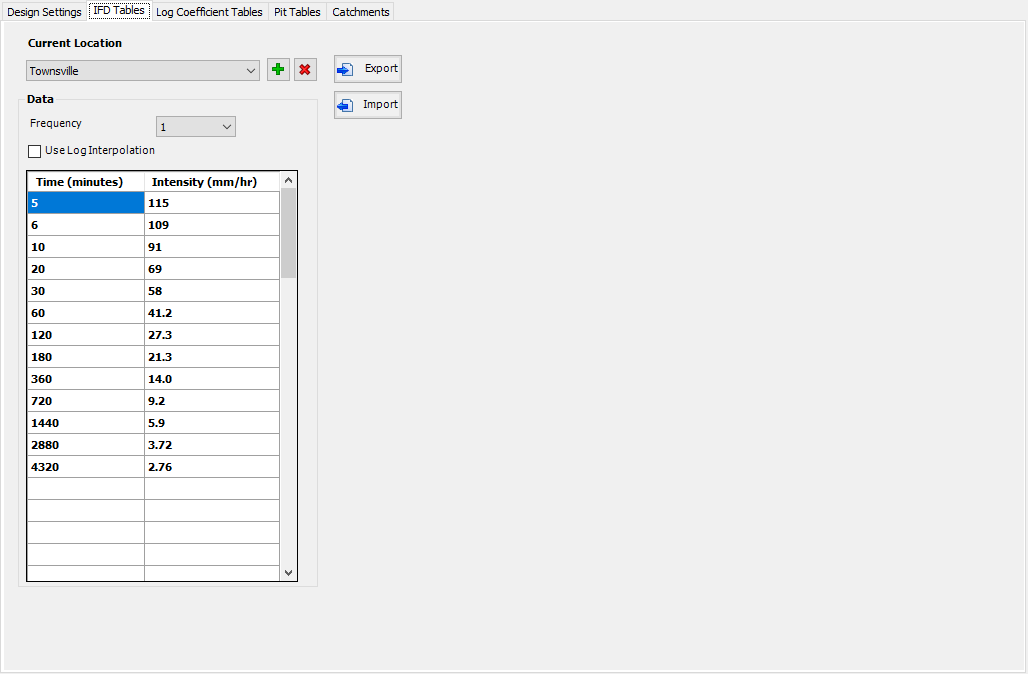
|
|
| Current Location | Select the current IFD table to be viewed/edit. |
|
|
Create a new IFD location. |
|
|
Delete the current IFD location. Note: The 'Default' IFD location cannot be deleted. |
|
|
Export the current IFD location to file. See Importing & Exporting Tables below. |
|
|
Import an IFD location from file. See Importing & Exporting Tables below. |
| Data | Define the data for the current IFD location |
| Frequency | Select the desired frequency to be created/edited (0.25, 1, 2, 5, 20, 50 or 100). All frequencies do not have to be entered, however if a frequency is used in the Design Settings and no data is entered for it, then the software will report 0 for that frequency in any reports and long sections. Note: The 0.25 is intended to be used for the 'Low Flow' frequency. |
| Use Log Interpolation | Tick box to Enable or Disable the logarithmic interpolation of the IFD data. When this option is OFF, the software will use linear interpolation of the data. |
| Time (minutes) | Enter the time in minutes. |
| Intensity (mm/hr) | Enter the Intensity in millimetres per hour. |
Log Coefficient Tables Tab
The Drainage - Log Coefficient Tables tab is used to define the Log Coefficient tables for various locations. The a Log Coefficient location can be selected as the Design Storm for the drainage analysis in the Design Settings tab.
Note: To adjust the focus to show information about a different tab, just click on the tab of interest.

|
|
| Current Location | Select the current Log Coefficient table to be viewed/edit. |
|
|
Create a new Log Coefficient location. |
|
|
Delete the current Log Coefficient location. Note: The 'Default' Log Coefficient location can not be deleted. |
|
|
Export the current Log Coefficient location to file. See Importing & Exporting Tables below. |
|
|
Import a Log Coefficient location from file. See Importing & Exporting Tables below. |
| Data | Define the data for the current Log Coefficient location |
| Frequency a b c d e f g | Enter the coefficients (a, b, c, d, e, f & g) for the various frequencies (0.25, 1, 2, 5, 20, 50 or 100). All coefficients for a specific frequency MUST be entered, however a specific frequency can be omitted. If data for a frequency does not exist and that frequency is used in the Design Settings, then the software will report 0 for that frequency in any reports and long sections. Note: The 0.25 is intended to be used for the 'Low Flow' frequency. |
Structure Tables Tab
The Drainage - Structure Tables tab is used to define the structure family and types that can be used in the project for drainage structures.
In the software, an individual structure is defined as a Structure Type and belong to a Structure Family.
When a structure of a defined drainage network is attached to a string the software will automatically change the structure type (excluding the null structure and all sag structures) to a structure within the same family with a Longitudinal Grade that best matches the longitudinal grade of the string the structure is attached to.
Note: To adjust the focus to show information about a different tab, just click on the tab of interest.
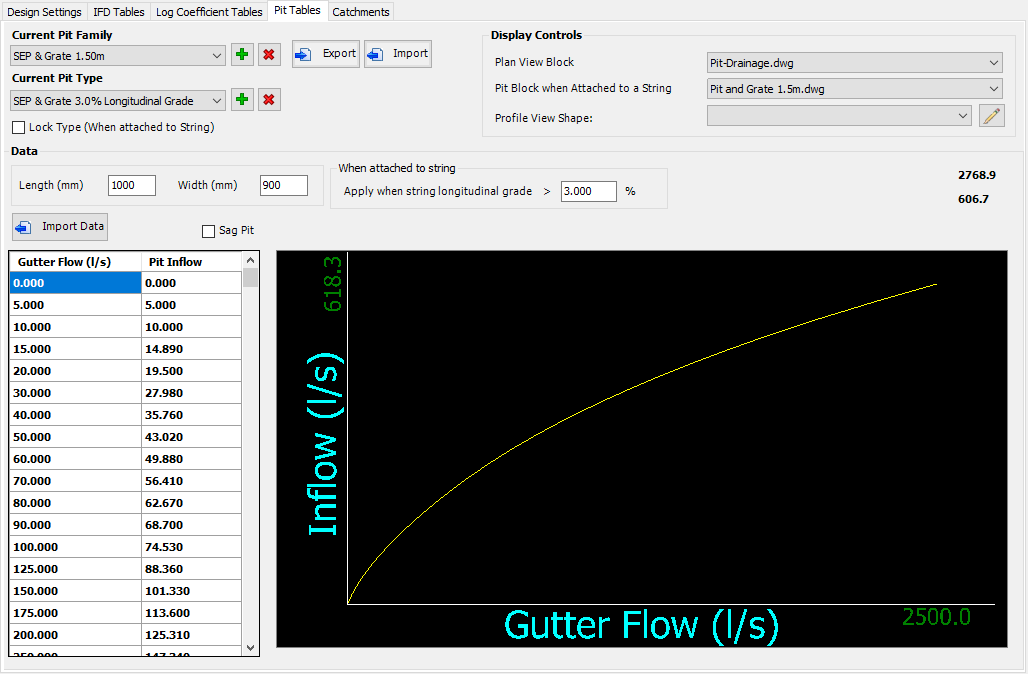
|
|
| Current Structure Family | Select the current Structure Family to be viewed/edit. Note: Irrespective of the data entered, the Null structure family will use no structure data to represent a pipe to pipe connection. The Display Controls are still used. |
 New
Structure Family New
Structure Family |
Create a new Structure Family table. |
 Delete
Current Structure Family Delete
Current Structure Family |
Delete the current Structure Family table. Note: The 'Default' Structure Family table cannot be deleted. |
|
|
Export the current Structure Family table to file. See Importing & Exporting Tables below. |
|
|
Import a Structure Family table from file. See Importing & Exporting Tables below. |
| Current Structure Type | Select the current Structure Type to be viewed/edit. Note: Irrespective of the data entered, the Null structure type will use no structure data to represent a pipe to pipe connection. The Display Controls are still used. |
 New
Structure Type New
Structure Type |
Create a new Structure Type. |
 Delete
Current Structure Type Delete
Current Structure Type |
Delete the current Structure Type. Note: The 'default' Structure Family location cannot be deleted. |
| Lock Type (When attached to String) | When this option is checked, the structure type is not reallocated based on string grade when structure is connected to a string. The structure type selected at time of creation, via Edit Structure Properties or via the VGE will be kept. |
| Display Controls | Define how the structure is displayed in the drawing. |
| Plan View Block | Select the block used to represent the drainage structure in the drawing. The block is aligned to the downstream pipe when the drainage network is defined. The blocks are initially loaded from the CSD Common folder and then from the drawing. |
| Structure Block when attached to String | Select the block used to represent the drainage structure in the drawing when it is attached to a road string. The block is automatically aligned to the road centreline when the drainage network is defined. The blocks are initially loaded from the CSD Common folder and then from the drawing. |
| Profile View Shape | USA Version Only - Select a Profile Shape to use for display in a Profile View. See Profile Views command. |
 Edit Profile View Shape Edit Profile View Shape |
USA Version Only - Click to open the Profile Structure Style manager. |
| Data | Enter the performance data for the current structure. Structures are assumed to be On Grade structures unless the Sag Structure option is selected. |
| Define the structure dimensions used in the Long Section plots and Reports. | |
| Length (mm) | Enter the length of the structure in millimetres. |
| Width (mm) | Enter the width of the structure in millimetres. |
| When attached to string | Define the minimum grade for the current structure when attached to a string. This is ignored when Sag Structure is selected. |
| Apply when string longitudinal grade > | Specify the string longitudinal grade as a percentage. |
 |
Users can read a Structure capture curve from a text table. When selected, Windows Explorer will open and allow the user to navigate to and select the appropriate file. The file should contain pairs of data separated by a space on each line. The pairs of data should be either "Approach Flow, Structure Inflow" for On Grade Structures and "Gutter Depth, Structure Inflow" for Sag Structures. Note: The text file units are m³/s for flows and m for depths. |
| Sag Structure | When this option is checked, the structure is assumed to be a sag structure. This also controls the left-hand side of the Input table below. |
| Gutter Flow (l/s) | For On Grade Structures only - Enter the gutter flow (arriving at the structure) in litres per second. |
| Gutter Depth (mm) | For Sag Structures only - Enter the gutter depth in millimetres (when Sag Structure is selected). |
| Structure Inflow (l/s) | Enter the structure inflow in litres per second. |
Catchments Tab
The Drainage - Catchments tab is used to configure how the drainage catchments are displayed and labelled.
Note: To adjust the focus to show information about a different tab, just click on the tab of interest.
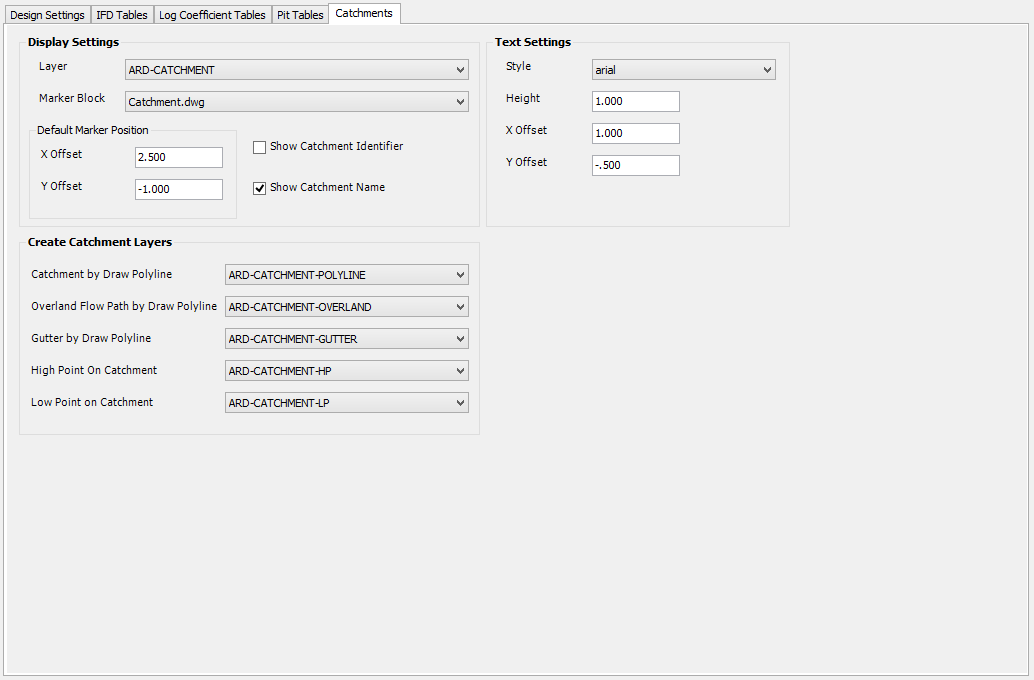
|
|
| Display Settings | Configure the display controls for drainage catchments. |
| Layer | Select the layer used to display drainage catchments (marker, label and connection line). Use the Edit Layer Settings command to edit the layers available. |
| Marker Block | Select the block used to represent the drainage catchment in the drawing. The blocks are initially loaded from the CSD common folder and then from the drawing. |
| Default Marker Position | Configure the default position of a catchment NOT associated with a polyline. |
| X Offset | Enter the X offset in drawing units from the structure. |
| Y Offset | Enter the Y offset in drawing units from the structure. |
| Show Catchment Identifier | Enable this option to show the catchment identifier in the drawing. |
| Show Catchment Name | Enable this option to show the catchment name in the drawing. |
| Text Settings | Configure the text settings used to show the catchment labels. |
| Style | Select the text style to be used. |
| Height | Enter the text height in drawing units. |
| X Offset | Enter the X offset in drawing units, from the catchment marker to place the label in the drawing. |
| Y Offset | Enter the Y offset in drawing units, from the catchment marker to place the label in the drawing. |
| Create Catchment Layers | Configure the layers applied for drawing the catchment area, flow line and gutter line. These controls are available when Creating/Editing Catchments. |
| Catchment by Draw Polyline | Select the layer used to display the catchment area. Use the Edit Layer Settings command to edit the layers available. |
| Overland Flow Path by Draw Polyline | Select the layer used to display the catchment flow line. Use the Edit Layer Settings command to edit the layers available. |
| Gutter by Draw Polyline | Select the layer used to display the gutter flow line. Use the Edit Layer Settings command to edit the layers available. |
| High Point on Catchment | Select the layer used to display the catchment high point text. Use the Edit Layer Settings command to edit the layers available. |
| Low Point on Catchment | Select the layer used to display the catchment low point text. Use the Edit Layer Settings command to edit the layers available. |
Sewer Tab
The Sewer tab is used to configure project settings specific to Sewer Networks. It is divided up into the following tabs (Click on a tab for more information about that tab):

Design Settings Tab
The Sewer - Design Settings tab is used to configure the various design settings used for the creation of sewer networks.
Note: To adjust the focus to show information about a different tab, just click on the tab of interest.

|
|
| Minimum Sewer Pipe Grade (%) | Enter the minimum grade for sewer networks. |
| Maximum Search Distance from Sewer to Find Downstream Structure of House Connection | Enter the distance in drawing units the software will search from a sewer network to find the downstream end of a house connection. |
Design Tables Tab
The Sewer - Design Tables tab is used to configure the various design tables used when creating, plotting and reporting sewer networks.
Note: To adjust the focus to show information about a different tab, just click on the tab of interest.

|
|
| Current Design Table | Select the current Design Table to be viewed/edit. |
|
|
Create a new Design Table. |
|
|
Delete the current Design Table. Note: The 'Default' Design Table cannot be deleted. |
|
|
Export the current Design Table to file. See Importing & Exporting Tables below. |
|
|
Import a Design Table from file. See Importing & Exporting Tables below. |
 |
There are several different sewer design tables as shown left. (Click on a tab in the image above for more information about that tab): |
Direction Change Structure Drops Tab
The Sewer - Design Tables - Direction Change Structure Drops tab is used to define the Direction Change design tables. This table is used when creating or updating a sewer networks to control the drop through a direction change structure (1 incoming pipe only).
Note: To adjust the focus to show information about a different tab, just click on the tab of interest.

|
|
| Data | Define the data for the Direction Change table. |
| Minimum Angle | Specify the minimum angle in degrees. |
| Maximum Angle | Specify the maximum angle in degrees. |
| Drop (mm) | Specify the structure drop to apply in millimetres. |
| Label | Enter the label required to identify the drop applied. |
Junction Structure Drops Tab
The Sewer - Design Tables - Junction Structure Drops tab is used to define the Junction Drop design tables. This table is used when creating or updating a sewer networks to control the drop through a junction structure (2 or more incoming pipes).
Note: To adjust the focus to show information about a different tab, just click on the tab of interest.
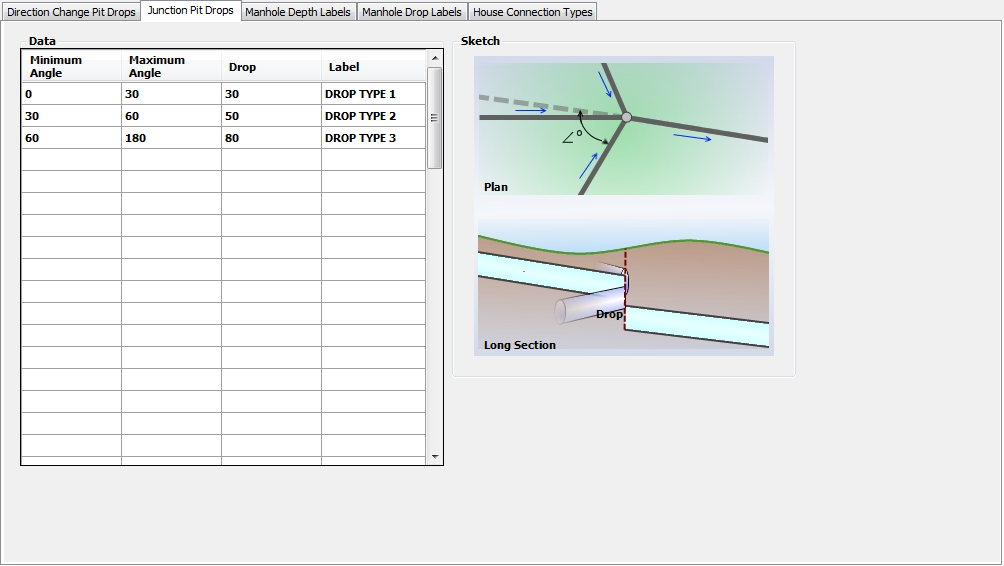
|
|
| Data | Define the data for the Junction Drop table. |
| Minimum Angle | Specify the minimum angle in degrees. |
| Maximum Angle | Specify the maximum angle in degrees. |
| Drop | Specify the structure drop to apply in millimetres. |
| Label | Enter the label required to identify the drop applied. |
Manhole Table Depth Labels Tab
The Sewer - Design Tables - Manhole Depth Labels tab is used to define the Manhole depth design tables. This table defines the lid type and manhole to use based on the structure depth.
Note: To adjust the focus to show information about a different tab, just click on the tab of interest.
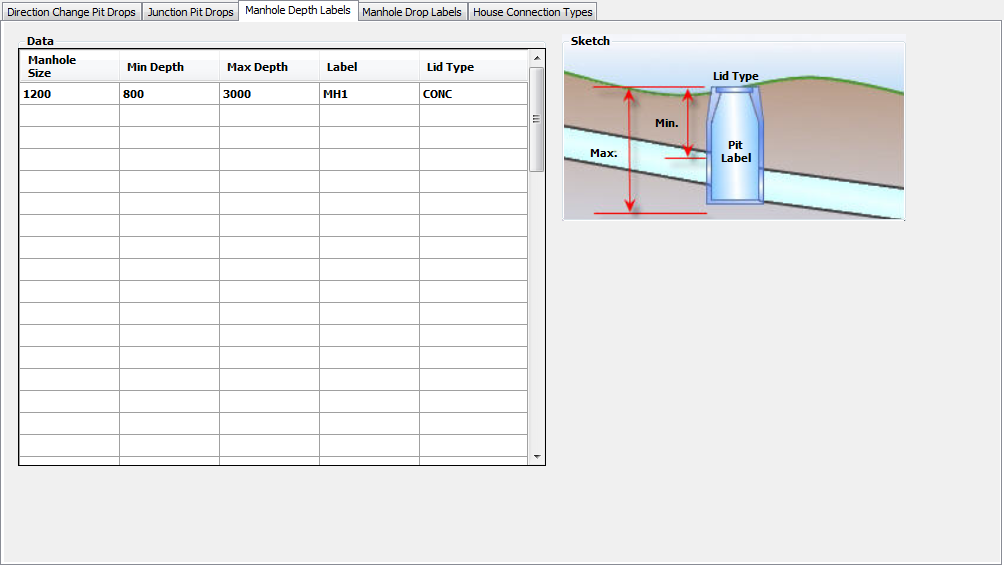
|
|
| Data | Define the data for the Manhole table. |
| Manhole Size | Specify the manhole size in millimetres. |
| Min Depth | Specify the minimum manhole depth from top of structure to sump in millimetres. |
| Max Depth | Specify the maximum manhole depth from top of structure to sump drop in millimetres. |
| Label | Specify the label. |
| Lid Type | Specify the manhole lid type. |
Manhole Drop Labels Tab
The Sewer - Design Tables - House Connection Types tab is used to label the house connections based on the depth from the house connection invert at the sewer down to the final connection at the sewer pipe. This information can be included in long section plot outputs.
Note: To adjust the focus to show information about a different tab, just click on the tab of interest.

|
|
| Data | Define the data for the Manhole Drop table. |
| MH Drop Type | Specify the manhole drop type. |
| Min Drop | Specify the minimum drop in millimetres. |
| Maximum Drop | Specify the maximum drop in millimetres. |
| Label | Specify the label. |
House Connection Types Tab
The Sewer - Design Tables - Manhole Drop Labels tab is used to define the Manhole depth design tables. This table is to identify different drop structures required based on the depth of drop through the structure.
Note: To adjust the focus to show information about a different tab, just click on the tab of interest.

|
|
| Data | Define the data for the House Connection Types table. |
| House Connection Type | Specify the house connection type for the specified drop range (ranging From Drop To Drop). |
| From Drop (mm) | Specify the minimum drop in millimetres. |
| To Drop (mm) | Specify the maximum drop in millimetres. |
Utilities Tab
The Utilities tab is used to configure the settings for utility obstructions.
Note: To adjust the focus to show information about a different tab, just click on the tab of interest.
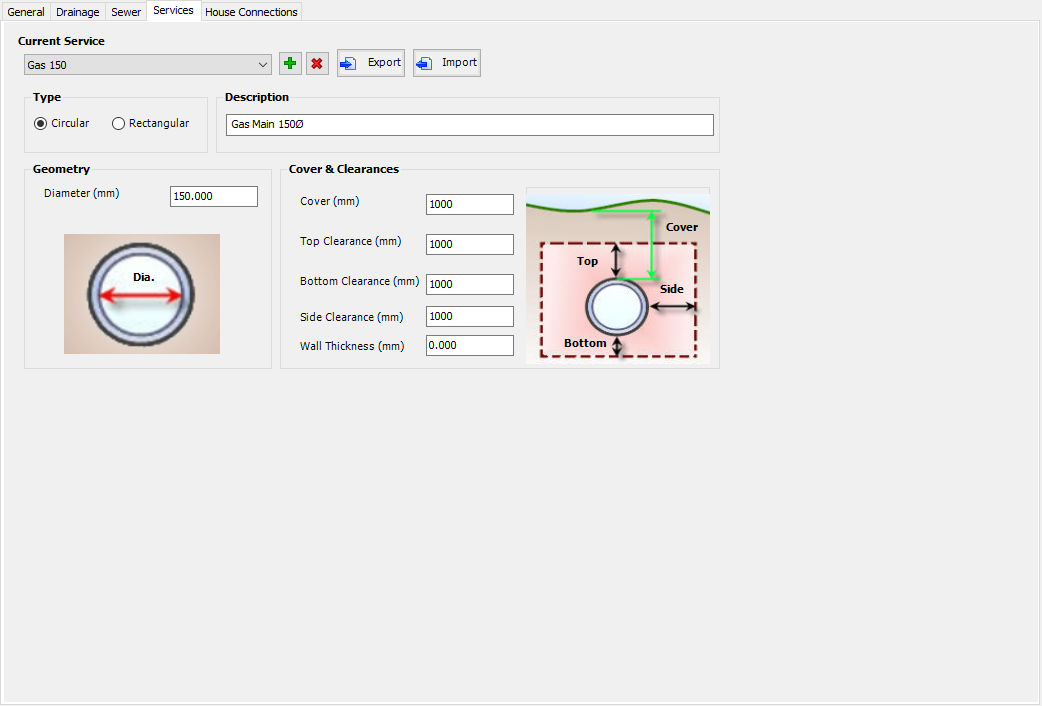
|
|
| Current Utility | Select the current Utility Obstruction to be viewed/edit. |
|
|
Create a new Utility Obstruction. |
|
|
Delete the current Utility Obstruction. Note: The 'Default' Utility Obstruction can not be deleted. |
|
|
Export the current Utility Obstruction to file. See Importing & Exporting Tables below. |
|
|
Import a Utility Obstruction from file. See Importing & Exporting Tables below. |
| Type | Select the utility obstruction type, either Circular or Rectangular. The image of the section will change pending the selection. |
| Description | Enter a description for the utility obstruction type. This is reportable on the long section plotting and reporting. |
| Geometry | Define the geometric properties. |
| Diameter (mm) | Specify the diameter of the circular utility obstruction in millimetres. Only visible when Circular type is selected. |
| Height (mm) | Specify the height of the rectangular utility obstruction in millimetres. Only visible when Rectangular type is selected. |
| Width (mm) | Specify the width of the rectangular utility obstruction in millimetres. Only visible when Rectangular type is selected. |
| Cover & Clearances | Set the cover and clearances. |
| Cover (mm) | Set the minimum cover in millimetres. |
| Top Clearance (mm) | Set the top clearance from the outside of the utility obstruction in millimetres. |
| Bottom Clearance (mm) | Set the bottom clearance from the outside of the utility obstruction in millimetres. |
| Side Clearance (mm) | Set the side clearance from the outside of the utility obstruction in millimetres. |
House Connections Tab
The House Connections tab is used to configure the design settings for the creation of house connections.
House connections are used as a constraint to assist in designing the drainage and sewer networks. The user should adopt a naming convention to distinguish between the two (2) different house connections that can be used.
Note: To adjust the focus to show information about a different tab, just click on the tab of interest.
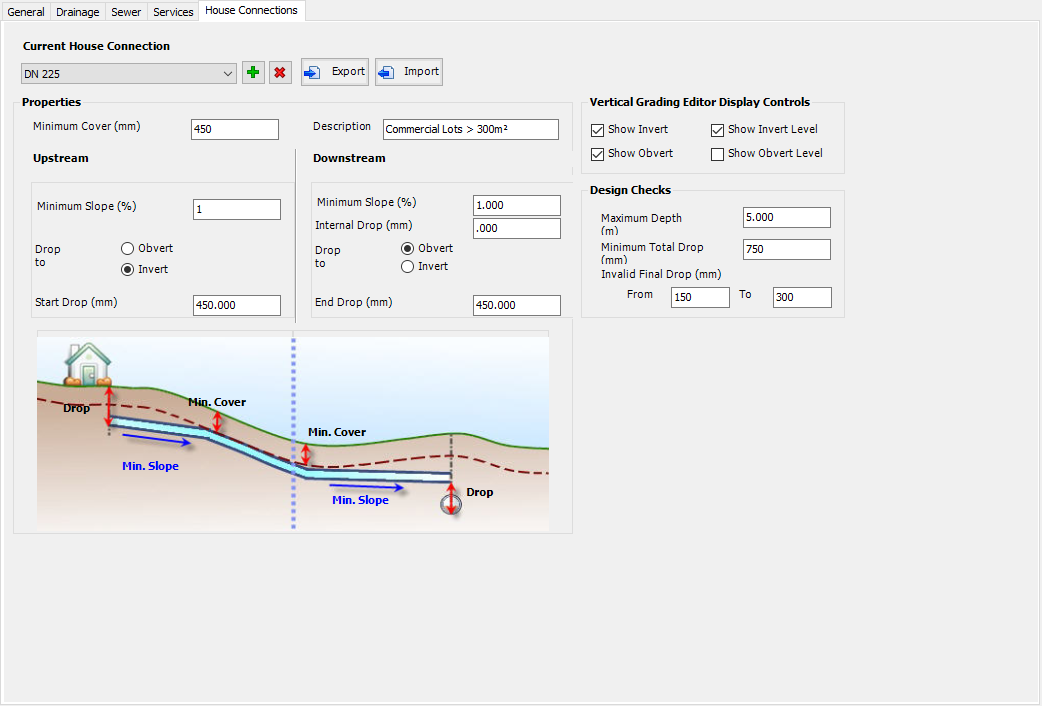
|
|
| Current House Connection | Select the current House Connection to be viewed/edit. |
|
|
Create a new House Connection. |
|
|
Delete the current House Connection. Note: The 'Default' House Connection can not be deleted. |
|
|
Export the current House Connection to file. See Importing & Exporting Tables below. |
|
|
Import a House Connection from file. See Importing & Exporting Tables below. |
| Properties | Define the design properties for the current house connection. |
| Minimum Cover (mm) | Specify the minimum cover in millimetres. |
| Description | Type in a description for the House Connection Type. This can be reported at the time of plotting House Connections during Long Section Plotting. |
| Upstream | Define the house connection upstream design controls. |
| Minimum Slope (%) | Specify the minimum slope in percentage. |
| Drop to | Define how the initial drop is defined. Select either Invert or Obvert. |
| Start Drop (mm) | Specify the initial drop in millimetres. |
| Downstream | Define the house connection downstream design controls. |
| Minimum Slope (%) | Specify the minimum slope in percentage. |
| Internal Drop (mm) | Specify the internal drop in millimetres. This is the drop applied when the house connection is created with an Internal Drop/Frontage Line control, at the Frontage Line. |
| Drop to | Define how the final drop is defined. Select either Invert or Obvert. |
| End Drop (mm) | Specify the end drop in millimetres. This represents the nominal drop required to enter the sewer pipe and acts a constraint level for the sewer design. The Final drop is subject to the sewer levels adopted. |
| Vertical Grading Editor Display Controls | Define how the house connection is displayed in the Vertical Grading Editor (VGE). At least one of the options should be enabled to show the house connection in the VGE |
| Show Invert | Enable or disable the display of the house connection invert on the VGE. |
| Show Invert Level | Enable or disable the display of the house connection invert level text on the VGE |
| Show Obvert | Enable or disable the display of the house connection obvert on the VGE. |
| Show Obvert Level | Enable or disable the display of the house connection obvert level text on the VGE |
| Design Checks | Indicates to the user if the house connection depths or drops are outside of a user defined range |
| Maximum Depth (m) | Specify a maximum depth value for the house connection in metres. This value represents the depth of the house connection outlet at the connection with sewer pipe. The user will be alerted if the maximum depth is violated, both at the time of creation and in a House Connections Report. |
| Minimum Total Drop (mm) | Specify a minimum total drop value for the house connection in millimetres. This value represents the level difference from the finished surface level (FSL) at the start of the house connection and the invert of the sewer at the house connection outlet. The user will be alerted if the minimum total drop is not achieved in a House Connections Report. |
| Invalid Final Drop (mm) | Specify a range defining invalid drop values from the house connection to the sewer pipe. The range of invalid drops is specified by setting the range of drop values in the From and To fields. The user will be alerted if the drop values fall within this range in a House Connections Report. |
| From | Specify a value representing a minimum invalid drop in millimetres. |
| To | Specify a value representing a maximum invalid drop in millimetres. |
Importing & Export Tables
Any of the design tables used in the Active Network Settings form can be exported to and imported from file. This is the best way to transfer a table to another project or to the Global Network Settings.
The design tables that can be exported and imported are:
- Pipe Tables (.ardPipes)
- Box Sections Tables (.ardBoxSections)
- Drainage IFD Tables (.IFDCoeffs)
- Drainage Log Coefficient Tables (.logCoeffs)
- Drainage Structure Tables (.ardStructures)
- Sewer House Connections (.houseCon)
- Sewer Design Tables (.sewDesign)
- Utility Obstructions (.services)
Exporting
When you choose to export any design table to a file a form, similar to the one below, is displayed. The Window header and Save as File Type will change to identify what type of Design Table is being exported.
|
|
| Save in | Specify the folder the file will be save to. |
File name |
Specify the filename. By default, the name will be the same as the table being exported. Specifying different name will also set the name of the exported table as well as the file name. |
Importing
When you choose to import any design table from a file a form, similar to the one below, is displayed. The Window header and File Type will change to identify what type of Design Table is being imported.
 |
|
| Look in | Specify the folder the file can be found in. |
| File name | Specify the file (design table) to import. |


